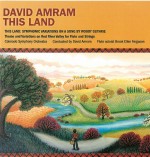 I was intrigued to receive a package from Woody Guthrie Publications in New York City and more so when I opened it to find it contained This Land: Symphonic Variations on a Song by Woody Guthrie by David Amram performed by the Colorado Symphony Orchestra (coloradosymphony.org). I first encountered the music of David Amram almost half a century ago on the soundtrack to the seminal Beat Generation film Pull My Daisy directed by Robert Frank and Alfred Leslie. The film included Amram’s jazz setting of the title poem written by Allen Ginsberg, Jack Kerouac and Neal Cassady. The somewhat haunting theme proved to be an earworm that has stuck with me since first hearing. (If you haven’t seen the film you can check it out at ubu.com/film/leslie_daisy.html.) My next exposure was at the Mariposa Festival one of the years it took place on the Toronto Islands where Amram was featured in a variety of guises, including in the children’s tent with Raffi who sang a catchy song to the tune of Arkansas Traveler with the words “Peanut butter sandwich made with jam, One for me and one for David Amram…” which still pops up in my ears from time to time. Amram is a renaissance man who is seemingly comfortable in all genres and on almost all instruments. A pioneer of jazz French horn and a trailblazer of the World Music movement, he is equally at home in the concert hall, having conducted more than 75 orchestras and performed as orchestral soloist on a host of different instruments. In 1966 Leonard Bernstein appointed him as the first composer-in-residence with the New York Philharmonic and his oeuvre extends to more than 100 orchestral and chamber works, several operas and a couple of notable film scores (Splendor in the Grass and The Manchurian Candidate). All of which is to say that he has impeccable credentials to pay tribute to one of the most iconic songwriters and chroniclers of American life.
I was intrigued to receive a package from Woody Guthrie Publications in New York City and more so when I opened it to find it contained This Land: Symphonic Variations on a Song by Woody Guthrie by David Amram performed by the Colorado Symphony Orchestra (coloradosymphony.org). I first encountered the music of David Amram almost half a century ago on the soundtrack to the seminal Beat Generation film Pull My Daisy directed by Robert Frank and Alfred Leslie. The film included Amram’s jazz setting of the title poem written by Allen Ginsberg, Jack Kerouac and Neal Cassady. The somewhat haunting theme proved to be an earworm that has stuck with me since first hearing. (If you haven’t seen the film you can check it out at ubu.com/film/leslie_daisy.html.) My next exposure was at the Mariposa Festival one of the years it took place on the Toronto Islands where Amram was featured in a variety of guises, including in the children’s tent with Raffi who sang a catchy song to the tune of Arkansas Traveler with the words “Peanut butter sandwich made with jam, One for me and one for David Amram…” which still pops up in my ears from time to time. Amram is a renaissance man who is seemingly comfortable in all genres and on almost all instruments. A pioneer of jazz French horn and a trailblazer of the World Music movement, he is equally at home in the concert hall, having conducted more than 75 orchestras and performed as orchestral soloist on a host of different instruments. In 1966 Leonard Bernstein appointed him as the first composer-in-residence with the New York Philharmonic and his oeuvre extends to more than 100 orchestral and chamber works, several operas and a couple of notable film scores (Splendor in the Grass and The Manchurian Candidate). All of which is to say that he has impeccable credentials to pay tribute to one of the most iconic songwriters and chroniclers of American life.
Lasting nearly 40 minutes, This Land uses the orchestral palette to paint a vast pastoral portrait of the land that Guthrie traveled so extensively and described so aptly in his songs. The work is divided into six main movements with descriptive titles: Theme and Variations for the Road (in which we first hear the familiar tune from the marimba) & Variation I: Oklahoma Stomp Dance; Variation II: Sunday Morning Church Service in Okema (Guthrie’s home town); Variation III: Prelude and Pampa Texas Barn Dance; Variation IV: Dreaming of Mexico; Variation V: Dust Bowl Dirge; Variation VI: Street Sounds of New York’s Neighborhoods (which includes Caribbean Street Festival, Klezmer Wedding, Salvation Army Hymn and Block Party Jam). The melody of This Land Is Your Land is cleverly woven throughout the textures of the work, sometimes hidden but never far from the surface, and appears in some surprising contexts such as the ground bass for the klezmer clarinet solo. My only concern is the overall subdued nature of the work. It never gets truly raucous or rambunctious and we never hear the hard edge of Guthrie’s gritty side, his working class hero with the emblem “this guitar kills fascists” etched on his axe. This Land is complemented with another pastorale, a mellow set of variations for flute and strings on the American classic folk song Red River Valley.
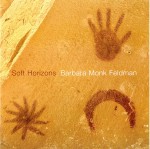 A disc that met all my expectations was recently released by New World Records (80765-2). Soft Horizons features works by Canadian composer Barbara Monk Feldman performed by pianist Aki Takahashi, the Flux Quartet and the DownTown Ensemble. It opens in a very contemplative mood with the title piece, a solo piano work reminiscent of the composer’s late husband and mentor Morton Feldman. The sparse, gentle, meandering work gives each note time to breathe before moving on, producing a wondrous sense of calm while at the same time creating a sense of anticipation as we await the next quiet event. Written in 2012, Soft Horizons is the most recent work presented.
A disc that met all my expectations was recently released by New World Records (80765-2). Soft Horizons features works by Canadian composer Barbara Monk Feldman performed by pianist Aki Takahashi, the Flux Quartet and the DownTown Ensemble. It opens in a very contemplative mood with the title piece, a solo piano work reminiscent of the composer’s late husband and mentor Morton Feldman. The sparse, gentle, meandering work gives each note time to breathe before moving on, producing a wondrous sense of calm while at the same time creating a sense of anticipation as we await the next quiet event. Written in 2012, Soft Horizons is the most recent work presented.
Although currently residing in Guelph, Monk Feldman lived for many years in New Mexico. Her 2004 String Quartet No.1 is subtitled Desert Scape and presents two visions of that geological phenomenon. The first begins with a consonant viola melody commented upon by bird- or insect-like sounds from the violins. As the movement develops the harmonies get closer in a kind of gentle abrasiveness which is supplanted by melodies echoed in higher octaves and later a Bartókian “night music” section, but in slow motion. The second movement maintains the sense of uneasy calm, this time with high melodies and commentaries in the lower strings. As the piece gradually unfolds we are drawn into a delicate soundworld where the sense of disquiet gradually seems to become the new normal.
The final piece, The Chaco Wilderness (2005), while maintaining the overall sonic mood of gradual progression adds a wealth of colour to the textures through its use of vibraphone, flute, clarinet, guitar/mandolin and piano. The work is in three contrasting movements and is the shortest by far on the disc. It may seem surprising that it contains the most “activity” per se, but I rather think that this is indicative of Monk Feldman’s style. The pieces in which “nothing happens” need a longer time frame to unfold.
All of the artists on this recording are masters of the genre. Aki Takahashi has been in the forefront of the avant garde since the 1970s, working with Cage, Xenakis, Boulez and Takemitsu to name but a few. In 1980 she was invited by Morton Feldman as a Creative Associate of the Center of the Creative and Performing Arts at SUNY, Buffalo. FLUX, which includes Canadian violist Max Mandel, was founded nearly 20 years ago and has been active on the New York scene ever since. Among their achievements is the performance (and recording for Mode Records) of Morton Feldman’s stunning five and half hour String Quartet No.2. The DownTown Ensemble, founded by Daniel Goode and William Hellermann, is now in its fourth decade of presenting experimental music in virtually all of its diverse forms.
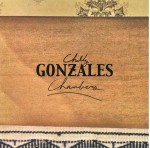 Coming at it from a very different angle, Europeanized Canadian MC/pop arranger/composer/performer Chilly Gonzales (aka Jason Charles Beck) has been working extensively with the Hamburg-based Kaiser Quartett lately and has just released a disc of original compositions for piano and string quartet. Chambers (Gentle Threat Records GENTLE016, chillygonzales.com) is intended as a reimagining of “Romantic-era chamber music as today’s addictive pop” and the project succeeds, with catchy melodies and warm harmonic writing. While it certainly doesn’t push any boundaries of new classical vocabulary it will open the ears of people who don’t normally have occasion to listen to string quartets or thoughtful instrumental music. The overall feeling of the disc is surprisingly laid-back, with only three of the twelve tracks proceeding at anything faster than a moderato pace, but this makes for a sense of continuity throughout. The titles are playful, including clever wordplay as in Prelude to a Feud, Freudian Slippers, and Green’s Leaves. One surprise is a slightly melancholy piece called Odessa, dedicated to the Ukrainian-born Russian composer Reinhold Glière. Another is a haunting vocal ballad, Myth Me, the earworm which concludes the disc. Concert Note: Chilly Gonzales and the Kaiser Quartett perform at Koerner Hall on April 21.
Coming at it from a very different angle, Europeanized Canadian MC/pop arranger/composer/performer Chilly Gonzales (aka Jason Charles Beck) has been working extensively with the Hamburg-based Kaiser Quartett lately and has just released a disc of original compositions for piano and string quartet. Chambers (Gentle Threat Records GENTLE016, chillygonzales.com) is intended as a reimagining of “Romantic-era chamber music as today’s addictive pop” and the project succeeds, with catchy melodies and warm harmonic writing. While it certainly doesn’t push any boundaries of new classical vocabulary it will open the ears of people who don’t normally have occasion to listen to string quartets or thoughtful instrumental music. The overall feeling of the disc is surprisingly laid-back, with only three of the twelve tracks proceeding at anything faster than a moderato pace, but this makes for a sense of continuity throughout. The titles are playful, including clever wordplay as in Prelude to a Feud, Freudian Slippers, and Green’s Leaves. One surprise is a slightly melancholy piece called Odessa, dedicated to the Ukrainian-born Russian composer Reinhold Glière. Another is a haunting vocal ballad, Myth Me, the earworm which concludes the disc. Concert Note: Chilly Gonzales and the Kaiser Quartett perform at Koerner Hall on April 21.
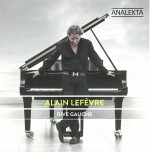 Another album with a somewhat similar feel comes from renowned classical pianist Alain Lefèvre who is known for his recordings of Chopin, Liszt and Mozart and also for his championing of the music of Canadian wunderkind André Mathieu (1929-1968). Rive Gauche (Analekta AN 2 9295) is a collection of Lefèvre’s own compositions, in his words “films for the ear, images for the piano” so it is likely no coincidence that the disc begins with a piece entitled Cinema Lumière. There is an overall sense of nostalgia in these warm, melodic pieces that range from swinging solo piano miniatures to chamber jazz tunes with the addition of bass (Michel Donato) and drums (Paul Brochu). Violinist Angèle Dubeau makes a cameo appearance on the tune Paris de mes souvenirs, a lovely ballad full of longing, and Léane Labrêche-Dor adds her pleasing jazz-infected voice to the closing track Au bout de mes rêves.
Another album with a somewhat similar feel comes from renowned classical pianist Alain Lefèvre who is known for his recordings of Chopin, Liszt and Mozart and also for his championing of the music of Canadian wunderkind André Mathieu (1929-1968). Rive Gauche (Analekta AN 2 9295) is a collection of Lefèvre’s own compositions, in his words “films for the ear, images for the piano” so it is likely no coincidence that the disc begins with a piece entitled Cinema Lumière. There is an overall sense of nostalgia in these warm, melodic pieces that range from swinging solo piano miniatures to chamber jazz tunes with the addition of bass (Michel Donato) and drums (Paul Brochu). Violinist Angèle Dubeau makes a cameo appearance on the tune Paris de mes souvenirs, a lovely ballad full of longing, and Léane Labrêche-Dor adds her pleasing jazz-infected voice to the closing track Au bout de mes rêves.
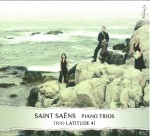 When we think of Camille Saint-Saëns (1835-1921) such works as the Carnival of the Animals, Danse macabre and the magnificent Organ Symphony come most readily to mind, but he also left some chamber gems behind, including a number of sonatas for various instruments, a piano quintet, a piano quartet and two piano trios. It is the Piano Trios which are featured on a new disc by Trio Latitude 41 (Eloquentia EL 1547 eloquentia.fr). The curious name of the trio stems from the geographical placement of both their first engagement in Rhode Island and the city of Rome, where the Italian cellist Luigi Piovano lives. The other members are American violinist Livia Sohn and Canadian-born pianist Bernadene Blaha, who for the past two decades has made her home in Los Angeles where she teaches at the University of Southern California.
When we think of Camille Saint-Saëns (1835-1921) such works as the Carnival of the Animals, Danse macabre and the magnificent Organ Symphony come most readily to mind, but he also left some chamber gems behind, including a number of sonatas for various instruments, a piano quintet, a piano quartet and two piano trios. It is the Piano Trios which are featured on a new disc by Trio Latitude 41 (Eloquentia EL 1547 eloquentia.fr). The curious name of the trio stems from the geographical placement of both their first engagement in Rhode Island and the city of Rome, where the Italian cellist Luigi Piovano lives. The other members are American violinist Livia Sohn and Canadian-born pianist Bernadene Blaha, who for the past two decades has made her home in Los Angeles where she teaches at the University of Southern California.
While far from unknown, these trios are quite underrepresented in the catalogue – only three other recordings of the two together, including one by the Vienna Piano Trio who appeared in Toronto recently courtesy of Mooredale Concerts, turned up on a quick search at Grigorian.com – and these sensitive and nuanced performances are a welcome addition. The trios were composed three decades apart, the first having been written in 1863 and the second not until 1892. The disc opens with the latter, with rumbling bass from the piano’s left hand and a welcoming melody from the strings accompanied by ebullient passages from pianist’s right hand. Although not a work we hear very often it sounds familiar in wonderful way, with hints of Mendelssohn’s A Minor Trio without seeming derivative. At 35 minutes it is an exhilarating and at times intense journey. The charming earlier trio, itself nearly half an hour long, is lighter and more playful, perhaps indicative of the youth of the composer, but balanced and well crafted. Both receive compelling performances in this rewarding release. I thank Trio Latitude 41 for bringing these works (back) to my attention.
Review
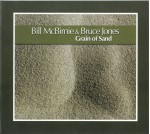 And in closing, something completely different – the latest from Mr. “Extreme Flute” Bill McBirnie. On Grain of Sand (EF07 extremeflute.com) McBirnie once again teams up with Latin multi-instrumentalist Bruce Jones, revisiting a partnership which resulted in the 1998 album Desvio. Jones wrote all the music, some of the tunes in collaboration with McBirnie, and the results are predominantly Brazilian-inspired samba and bossa nova style with plenty of Jones’ distinctive nylon-string guitar and vocals. Although only the two musicians are involved they have used the recording studio to good advantage, creating a multi-layered offering that is especially effective in the flute duet over guitar and ambient drone in Lembrando Paul Horn (Remembering Paul Horn). Other influences include hip-hop and funk and the end result is a diverse mosaic ranging from the mellow Vai Bem Devagar (Proceed with Caution) to the bouncing Cê Tá Com Tudo (You Are Everything), while maintaining an integral continuity. McBirnie’s flute, although not particularly “extreme” in this instance, is lively and lilting as it soars over the bed tracks laid down by Jones, in the forefront in the instrumental tunes where it has the dominant melody and tastefully in the background or heard in duet with Jones’ voice in the songs with lyrics. I only wish they had included the words and translations in the package. This is good time music, well played and obviously enjoyed by McBirnie and Jones. It takes me back to my introduction to this genre back in the 1970s when I first heard Brazilian icon Jorge Ben (Jor). Thanks for the memories!
And in closing, something completely different – the latest from Mr. “Extreme Flute” Bill McBirnie. On Grain of Sand (EF07 extremeflute.com) McBirnie once again teams up with Latin multi-instrumentalist Bruce Jones, revisiting a partnership which resulted in the 1998 album Desvio. Jones wrote all the music, some of the tunes in collaboration with McBirnie, and the results are predominantly Brazilian-inspired samba and bossa nova style with plenty of Jones’ distinctive nylon-string guitar and vocals. Although only the two musicians are involved they have used the recording studio to good advantage, creating a multi-layered offering that is especially effective in the flute duet over guitar and ambient drone in Lembrando Paul Horn (Remembering Paul Horn). Other influences include hip-hop and funk and the end result is a diverse mosaic ranging from the mellow Vai Bem Devagar (Proceed with Caution) to the bouncing Cê Tá Com Tudo (You Are Everything), while maintaining an integral continuity. McBirnie’s flute, although not particularly “extreme” in this instance, is lively and lilting as it soars over the bed tracks laid down by Jones, in the forefront in the instrumental tunes where it has the dominant melody and tastefully in the background or heard in duet with Jones’ voice in the songs with lyrics. I only wish they had included the words and translations in the package. This is good time music, well played and obviously enjoyed by McBirnie and Jones. It takes me back to my introduction to this genre back in the 1970s when I first heard Brazilian icon Jorge Ben (Jor). Thanks for the memories!
We welcome your feedback and invite submissions. CDs and comments should be sent to: DISCoveries, WholeNote Media Inc., The Centre for Social Innovation, 503 – 720 Bathurst St. Toronto ON M5S 2R4. We also encourage you to visit our website thewholenote.com where you can find added features including direct links to performers, composers and record labels, expanded and archival reviews. David Olds, DISCoveries Editor discoveries@thewholenote.com



